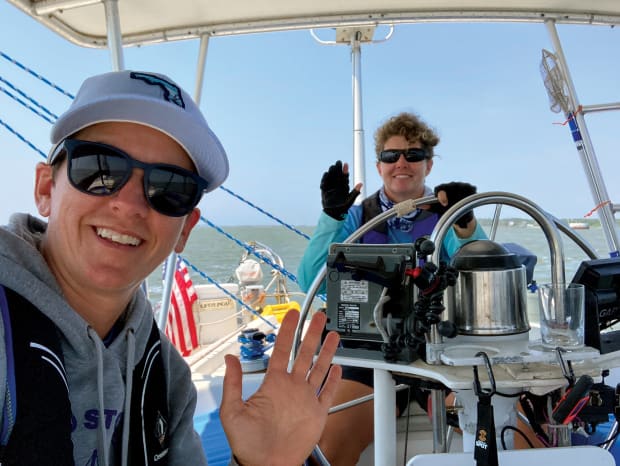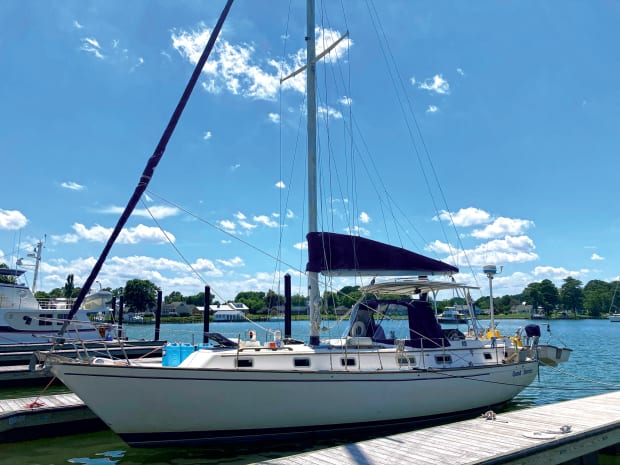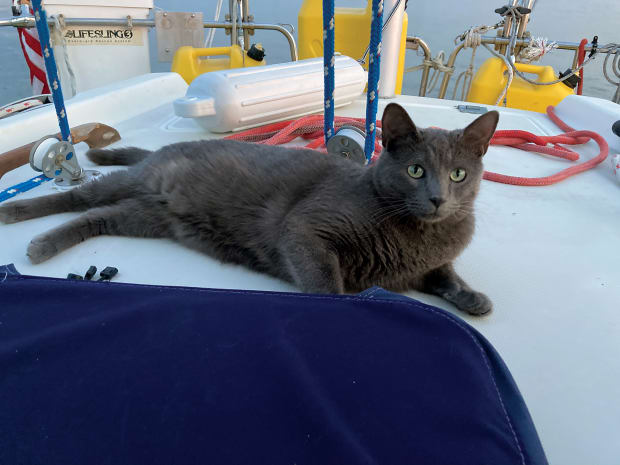
After the long and tiring 2020 pandemic year, and after many talks about hypothetically sailing away, my partner, Vanessa, and I decided it was time to stop daydreaming and start planning.
What makes us different from many cruising couples is the fact that we are under the age of 50. This presented a different set of challenges that forced us to get creative in our preparations. What follows are 10 steps we took to become “cruising ready.” Of course, everyone’s situation is unique. You don’t have to follow this word for word. Mix, mold and think of these steps as a guide to help you with your personal goals. The main thing is that you get going on making your dreams come true the same way we did.
1) Save Money: Again, we’re not retired, which means we also do not have retirement income. The first thing we did, then, in preparation for casting off lines was reduce our overhead. Things like canceling subscriptions (Netflix, Amazon, magazines, etc.), and selling furniture and other items we didn’t need was a good place to start. Vanessa already lived on the boat; I did not. I had an entire house full of stuff to deal with. What I didn’t sell, went into storage, which we’ll talk about later. Vanessa created a spreadsheet estimating how much we would potentially spend on this trip so we could determine how much we should save. Groceries, marina stays, boat maintenance, etc. were all on this spreadsheet. Also, while we still had full-time jobs, we made sure a portion of our income was going into a joint bank account designated for our trip.
2) No Debt: We can’t stress this enough. Neither of us has any debt. No credit card debt, car payments, student loans, no mortgages. We also did not take out any loans to take this trip. Not everyone can do this. If you have a house and you can’t or don’t want to sell, look to rent it out. If you have credit card debt or other loans, get serious about paying them down. We sail debt free, which means also being able to sail financially stress free. It gives us freedom, and that makes a huge difference.

3) Pick a Date: Although we started talking about this idea in June of 2020, we knew that it would remain just “talk” until we picked a date. Eventually, we landed on March 28, 2021. That gave us nine months to save, plan and prepare. Without this date, we honestly think this idea would have remained an idea. We needed a goal to shoot for and to make this entire cruising plan more real. So, pick a date and stick to it.
4) Deal With Your Day Job: If you have a day job, which most of us do, you need to figure out what you’ll do moving forward. In Vanessa’s case, she was able to stay with her employer on a part-time basis. She’s a web developer and can work from the boat. She works on those days we don’t travel, and so far, it’s been great. I wasn’t able to stay with my employer, so I don’t have a day job at the moment. This is where those savings come in. I saved bearing in mind that I might not have any steady income for a while. That said, as a video editor and graphic designer, I am able to do freelance work on the boat as it becomes available.
5) Health Insurance: We are lucky, we don’t have families to support, and we are both healthy. We worked with an insurance broker, and he helped us navigate the health insurance marketplace. I fully believe that we could have navigated it ourselves, but it was great to have the guidance of an expert. He took into account how much money we would be making, what our health needs were, our ages and other factors to determine the individual plans that would work best for us. Carrying our own health insurance is not that expensive, and the process of signing up was not hard at all. Don’t let this step hold you back. You can find great health insurance and not spend an arm and a leg.
6) Pack Up Your Life: What about all our stuff? When we finished selling or throwing away things we no longer needed, I found a very affordable storage unit. We took everything that was in Vanessa’s current storage unit, everything that was left in my house and packed up my screen-printing business (which I placed on pause) and we put it all in a single larger unit, which we now have on auto-debit so the rent automatically comes out each month. Pro tip: the storage facility will inevitably raise your rent in the first three to six months. Get on the phone with them and work out a lower rate. You won’t get your starting promotional rate, but looking at the numbers over time, you’ll see that you’re still getting a good deal.

7) Boat Projects: There were a number of things Vanessa felt needed doing before the trip. These included installing solar panels, getting side curtains for the cockpit, buying a new mattress and fixing the plumbing, to name a few. These were things she deemed absolutely necessary. Even after those, she still has a list of things that need to be done to improve the boat, but if she’d continued to work on that list before we left, we would never have left. A lot of the things that still need to be done can either wait until we’re back to our home port of St. Petersburg or get worked on during the trip as needed. So, prioritize what needs to be done before you leave and what can wait.
8) Know Your Boat: It’s very important to know the intricacies of your boat before embarking on any kind of long-term trip. Know how your systems work. Know how the boat handles in heavy weather. Know the sounds your boat makes, so you’ll recognize anomalies when you hear them. Have redundancies and plenty of spare parts, like an extra water pump or extra hoses. You’ll inevitably need this stuff, and sometimes you won’t be close to land or have access to a store to get it. If you can help it, do not buy a boat and then use a long cruise like the one we’re making as your shakedown trip.
9) Talk to Other Cruisers: Even though our trip was unique to us, it’s not unique to other cruisers. Hundreds of sailors go on similar adventures every year. Vanessa reached out to friends to pick their brains. Find out what they would have done differently, things you should watch out for and tidbits like where the best anchorages were. There are tons of different boating groups on Facebook, with built-in communities ready to answer questions and help when needed. Talking to other cruisers both demystified much of what lay ahead and reassured us that we were up to the challenge of whatever lay in story. There wasn’t a single cruiser who ever said to us, “You can’t do this,” which provided a huge boost to our overall confidence.
10) Choose Your Partner Wisely: Your sailing partner maybe your spouse, a family member or a friend. Whoever they are, make sure that you get along. Also make sure the two of you communicate effectively. There’s nothing worse than being stuck on a boat with someone you don’t agree with or are not getting along with. Vanessa and I talk, talk, talk, not just because we’re talkative people, but because we depend on each other. Physically, mentally and emotionally we have to be on the same page. We also know when to compromise and when to admit we’re wrong. Along these same lines, be open to new ideas or changes in plans. Our plans change almost every day due to weather, currents, tides, you name it. Be flexible and take care of each other. It will make the trip and experience that much more worthwhile.
Ed Note: The author, her partner Vanessa Goodrum and Whip the cat have been cruising up the East Coast for over a year now aboard the Pearson 385, Good Stories. You can follow them on their journey on YouTube, Facebook, Instagram and TikTok at 2 Women Sailing
Photos by Sara O’Brien
May 2022








